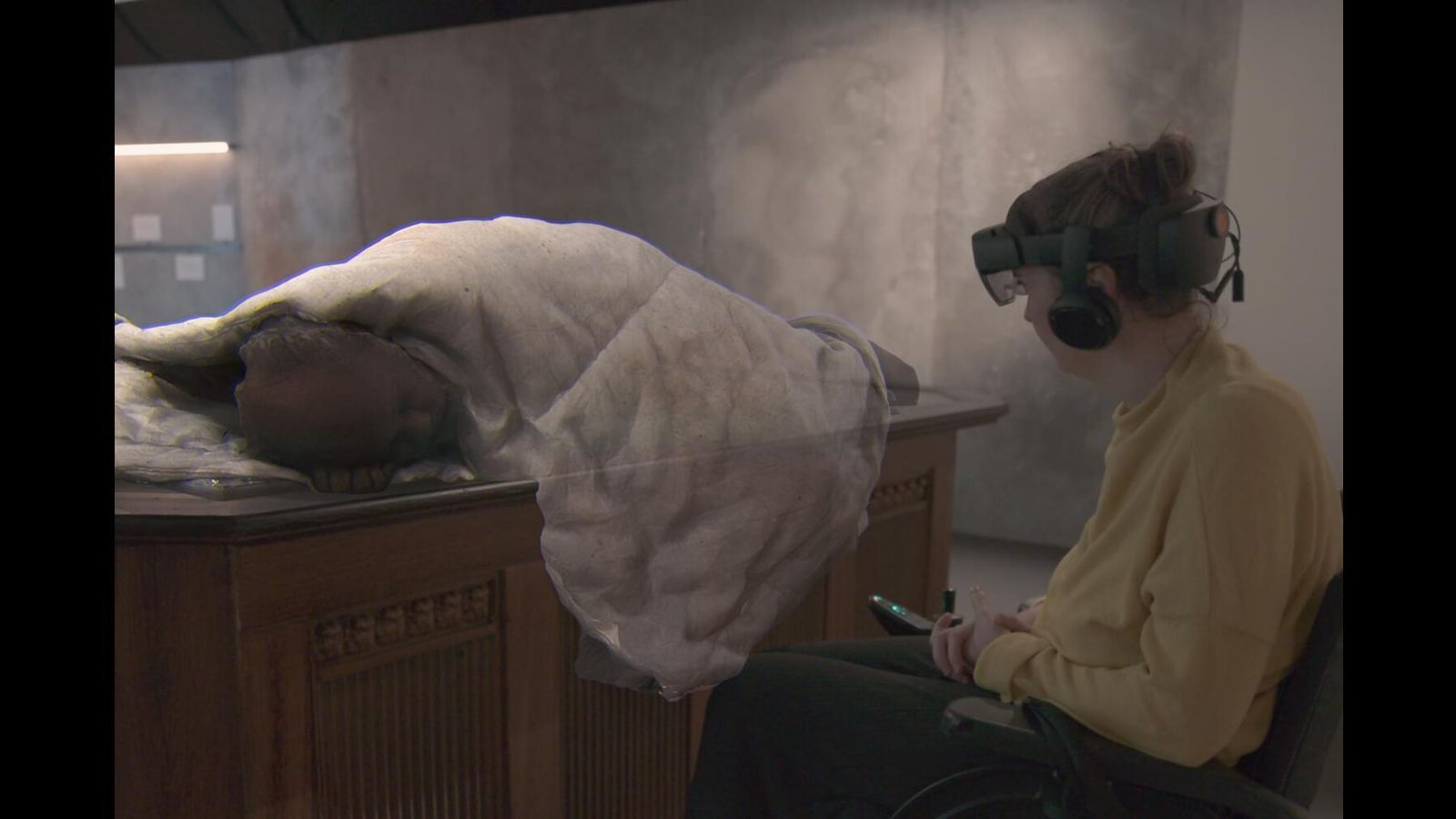Museum of Austerity, recently displayed at the HOME arts centre in Manchester, UK, brings to life the terrible plight of 10 of the disabled victims of a brutal and inhumane benefits system who were failed and left to die.
The exhibition, co-produced by the English Touring Theatre and Trial and Error Studio, combines the skills of theatre/XR director Sacha Wares and the in-depth knowledge of John Pring, editor of the Disability News Service (DNS).
The installation utilises holographic/augmented technology creating life like images and recorded interviews with family members drawing together the terrible personal and social impact of over a decade of brutal austerity.
The viewer is provided with a headset and walks into an empty space. One is then struck by the glowing images, played by actors, of 10 of the victims coming to life within touching distance. Recorded testimony is provided from a real family member fed through the wearer’s headset.
In the background is heard the voices of politicians in the House of Commons pontificating on how the benefits system is far too generous and facing fraudulent claims.
Standing in front of each one of these images, their stories are described in harrowing step by step detail, showing how they were failed by an inhumane and punitive benefit system, administered by the Department of Work and Pensions (DWP)
Listening to what happened to each of the victims, one is left wondering how could this have happened in one of the richest countries in the world? What if anything was in place to protect these people, who were clearly vulnerable, and struggling to engage with a benefits system, but were left to die?
David Clapson’s sister Gill Thompson speaks about the period leading to his tragic, preventable death. David had diabetes and died in July 2013 due to an acute lack of insulin. His only paltry form of income, Job Seekers Allowance, was sanctioned just three weeks earlier. He was unable to afford to pay for electricity to be able to keep the fridge running where he had to store his insulin.
An autopsy revealed that his stomach was empty. The only food found in his flat were six tea bags, an out-of-date tin of soup and a can of sardines. He had just £3.44 left in his bank account. The DWP admitted that they were aware that David was insulin dependent. Gill said, “I feel that the sanction resulting in my brother being left destitute and having no money to chill his insulin or to buy food, ultimately led to his untimely death”.
Imogen Day, sister of Phillipa Day, said she had been claiming Personal Independence Payment (PIP) until it was stopped by the DWP. Phillipa was a vulnerable 27-year-old who was found at home after having taken an overdose in August 2019. She died two months later in hospital. An inquest into her death held in January 2021 found that there had been 28 instances where systematic errors by both the DWP and Capita—a private sector firm—had led to failures in the handling of her benefits claim. Capita were carrying out assessments for PIP.
Following her PIP being stopped, Phillipa’s weekly income fell from £228 to £60 a week. At the inquest, a telephone recording was played of Philippa pleading with a benefits official for help. She can be heard crying telling the official, “I’ve been waiting for six months now. I’m literally starving, I can’t survive for much longer”. She added, “[I’m in] £5,000 debt. Nothing to eat. I’ve lost all my [benefit] premiums… I cannot survive… without any money. I need something to live for”.
The coroner ruled that although he was unable to conclude she intended to take her own life, the failures were a stressor in her decision to take the overdose.
The cases examined at the Museum of Austerity reveal a benefit system in chaos, with claimants victimised and denied access to social security. At the same time DWP staff are struggling due to unrealistic workloads, with many ending up having to leave.
Disability News Service revealed that a third of work coaches on a single floor of a job centre in Oxford have experienced a mental health crisis in less than a year. Oral evidence showed that working conditions were so stressful that in a team of 23 work coaches, 15 had quit the job within a 12-month period.
The resignations followed the introduction of the DWP’s “Way to Work” scheme launched in January 2022, set up to significantly increase the numbers of Universal Credit claimants returning to work who had lost their jobs during the pandemic. It set a target of forcing 500,000 people into employment by cutting job seekers’ benefits after four weeks unless they applied for work outside their normal occupation.
Work coaches at the Oxford job centre told DNS that the new scheme meant they had to deal with 27 appointments a day, when they had previously had to see between 17 and 19 a day.
The attacks on disabled people claiming benefits will intensify with Chancellor Jeremy Hunt’s Autumn Statement announcement that those on welfare payments who do not find a job within 18 months will be forced to undertake work experience. After six months of sanctions if they have still not got a job, they will lose their benefits altogether and even the right to free National Health Service prescriptions and legal aid. These measures will impact hundreds of thousands from 2025, with Hunt boasting they will save the government £4 billion.
“Premature mortality attributable to socioeconomic inequality in England between 2003 and 2018: an observational study,” by the University College London, published in 2019 in The Lancet Public Health, found that between 2003 and 2018, 877,000 people died as the result of rocketing social inequality.
An important part of the exhibition is a meticulous timeline used by the curators, titled, “Deaths by Welfare”, chronicling the attacks carried out on the welfare state by Tory and Labour governments from its initial conception in the 1942 wartime Beveridge Report to the present day.
Under conditions in which both the Sunak government and Labour opposition are committed to continuing austerity whoever wins the general election, this hard-hitting exhibition struggled to find venues willing to host it.
Wares has directing productions for more than 20 years, in her words to “tell stories that reflect the concerns of our times”. These include a 2004 production, Guantanamo, dealing with the “rendering” (kidnapping) and savage treatment of detainees in that hell on earth. She said, “As a theatre director I’ve been fortunate because usually when I want to make something there’s a home for it and I can get it made”. Now there is a backlash. “It’s been really striking with this piece of work that’s not been the case. And you wonder: is that a change in the confidence of the sector to be political?”
Museum of Austerity deserves the widest audience. The powerful exhibition is innovative and stands as an indictment not just of a slashed to shreds, punitive system that has systematically persecuted benefit claimants—even to their deaths—but of the entire political set-up which exists only to benefit a super-rich minority and the profit lust of the capitalist class.
Museum of Austerity was shown at HOME from November 8-11 and is showing at a number of venues during spring 2024 to be announced.



@Fudoshin @[email protected]
And I’m reminded, as a psychologist and a Buddhist,* that being kind and humane to others benefits us, too. It really does.
____
(*In my over-educated view, being a psychologist and a Buddhist are the same thing in the end.)